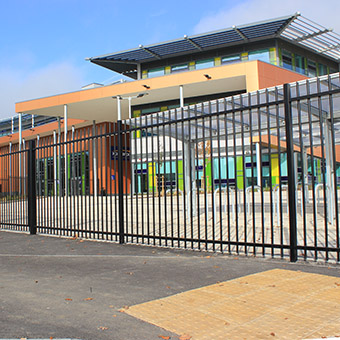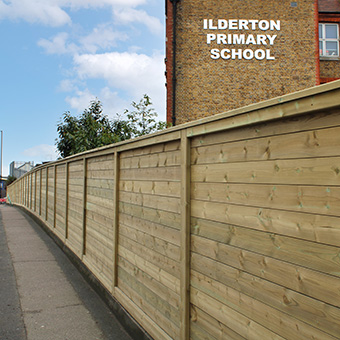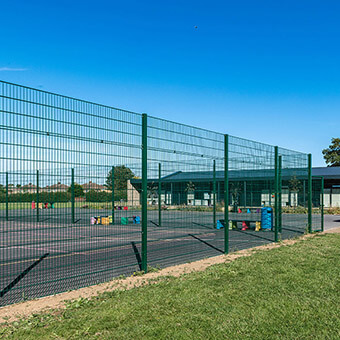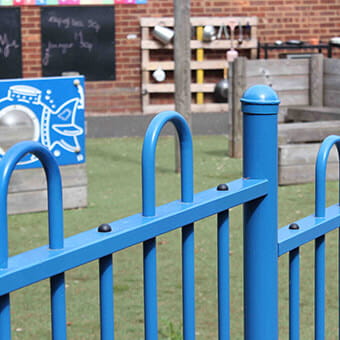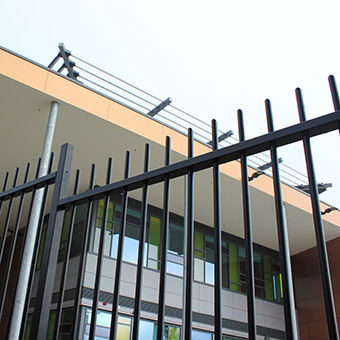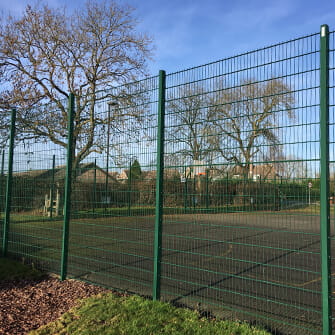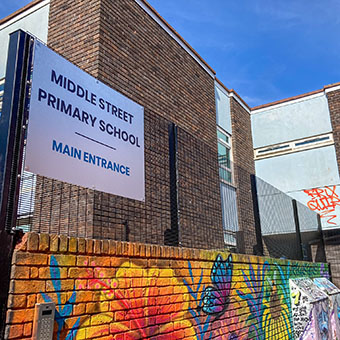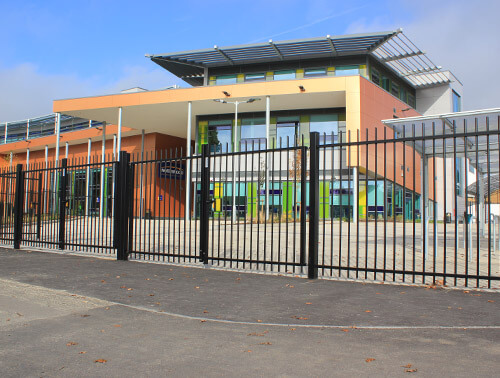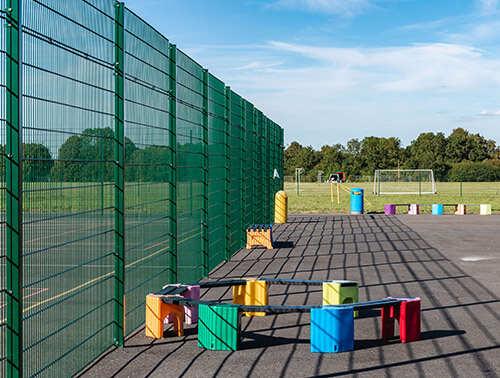Our other sites:
Jacksons has been involved in the design and manufacture of fencing and gates since 1947. Over the past 10 years alone, Jacksons have delivered over 750 projects each year to education facilities in the UK, from pre-school, to primary and secondary schools to colleges and universities.
At heart, all Jacksons steel and timber fencing and gates are designed and manufactured to be fit for purpose and provide a long service life and low whole-life cost. In 1995, Jacksons was the first company in the UK to offer an industry-leading 25-year guarantee on timber products.
Today, Jacksons remains the only company able to offer steel, timber, timber and steel combination fencing and gates tested and certified to LPS 1175 (A1-E10) and also Secured by Design accredited to Police Preferred Specification.
Making Sustainable Timber Fencing
The timber employed in the manufacture of Jacksons fencing and gates is specially selected from responsibly managed sources, and where requested, FSC and PEFC certified timber can be used. However, the use of sustainable timber only really makes sense to the environment if everything else is aligned. Starting from the selection of the right species of timber for its suitability to a given application, whether for example in the construction of a fence panel, gravel board or post, to the design of the finished product, the fixings used in its construction, the fittings attached to it and of course the way the timber is treated to ensure a long service life. By focusing on these aspects, we can build a sustainable future and confidently offer a 25 year guarantee.
Why do we treat our timber fencing?
All softwood, unless correctly treated is vulnerable to attack by wood boring pests and susceptible to rot which is why all timber used in a Jacksons product is first kiln dried to under 30% moisture which effectively creates the capacity for the wood fibres to absorb the preservative before undergoing the company’s proprietary ‘Jakcure’ vacuum pressure process. The Jakcure process has been continuously developed over the past 23 years to ensure the preservative penetrates through the sap wood and deep into the heart wood by employing a combination of conditioning, immersion and vacuum pressure.
The effectiveness of the Jakcure process against rot and insect attack and the use of traditional woodworking joints, stainless steel fixings and galvanised steel fittings allow Jacksons to offer an industry leading 25-year guarantee against all wood-boring pests and all forms of wet and dry rot across its entire range of timber fencing, gates, landscaping materials and structures.
Naturally, the preservative used to treat Jacksons timber is non-inflammable, non-corrosive and does not reduce the strength of the timber or make it brittle. It will not soil hands or clothing and is harmless to man, animal and plant life.
Are concrete fence posts good for the environment?
Concrete posts have long been used for timber and chain link fencing and many perceive that it’s the lowest maintenance and most durable option available; and therefore, economical and good for the environment.
They are certainly heavy and inherently strong but as to their durability and environmental benefits, there a number of myths that should be debunked.
Just as with timber posts, all concrete posts are not made equal. The best are made in controlled environments where the steel rods (rebar) encased within the structure are fully encased by the concrete skin with no air holes or fissures that water can enter and cause both unseen rust and induce mechanical stresses which make the post liable to frost damage and premature failure.
Unlike timber posts, the sheer weight of concrete posts means they often require additional transportation and more labour to move around a site and to install.
Environmental Impact of concrete fencing
A major component of concrete is cement, which carries its own set of environmental impacts.
Alongside the blighting of the landscape and removal of fertile topsoil to source the raw materials of limestone, clay, marl or shale, the production of cement consumes a vast amount of energy and water and after coal-powered electricity, cement manufacture is the next biggest contributor to the production of greenhouse gases, accounting for approximately 5% of annual anthropogenic global CO2 production; and at the end of its useful life, concrete is also costly and difficult to recycle often ending up in landfill.
Concrete posts offer few, if any benefits, against well treated timber posts in terms of strength, durability and service life and so far as cost is concerned, there is little difference between the price of a good concrete post and a good timber post. Where the differences lie is in aesthetics and carbon footprint where concrete posts are generally less attractive than timber and also consume more energy and create more CO2 in production, transportation and disposal. Needless to say, Jacksons don’t offer a concrete post option.
Sourcing Sustainable Steel Fencing
It takes a great deal of energy to produce steel. From the mining of ore, the smelting and rolling processes to transportation and manufacturing. But once manufactured into fencing and gates, you should expect a long and largely trouble-free service life.
Unfortunately, that’s not always the case. As with timber, there are different types of steel and metals suited to different applications and in fencing and gates for example, the use of solid steel bar has largely been replaced by hollow section tubular steel which is not only lighter and less costly, but by using the correct specification and size of steel section, can be just as strong and equally durable. While untreated softwood will weaken through the effects of rot and insect attack, untreated or inadequately treated steel is similarly weaken by fatigue and rust and surprisingly quickly too.
Choosing the right steel fence coating
To reduce cost, some manufacturers apply a primer/undercoat of red oxide or zinc rich coating on to bare metal to give a basic layer of corrosion protection. By way of contrast, the hollow steel sections used in a Jacksons vertical railing style fence or gate are hot dip galvanised inside and out to BS EN 1461 after manufacture, for total protection against rust; and if required, subsequently powder coated in a range of standard or special BS and RAL colours to BS EN 13438 at their onsite powder coating plant. If a fence or gate is to be used within 500 metres of an estuary or in a corrosive atmosphere, a ‘Marine Coating’ tested to ASTM A926-94 should be applied after galvanising for lasting protection against the elements.
With steel mesh panel style fencing, the shortcuts on quality and resultant performance and durability can be harder to detect. Wire sizes (gauge) are often reduced and many manufacturers routinely use zinc pre-galvanised wire in their panel construction as it is significantly cheaper than a zinc-aluminium alloy coating which offers up to 50% better corrosion resistance.
Other factors that can affect the service life of steel fencing and gates as much as the infill between the posts can be found in the fence panel to post fixings and, often overlooked, the correct post size and foundations to support the fence against high wind loading.
Jacksons steel fencing and gates all feature concealed or vandal-proof panel to post fixings and are covered by an industry-leading 25 year Service Life Guarantee against inherent defects such as design, manufacturing, finish and fitness for purpose. The wire used in the construction of a Jacksons steel mesh panel fence and gate is zinc-aluminium alloy coated as standard to BS EN 10224-2:2009 class B while steel railing designs along with all posts are hot-dip galvanised to BS EN 1461 as standard and may be further powder-coated to BS EN 13438 or Marine Coated in any colour, including green, at additional cost.
Related Products
We have completed over 5000 education projects in the last ten years and have a huge range of school fencing and gates, all guaranteed for 25 years. Browse individual products or view the full range below.
School FencingRelated Content
Top
